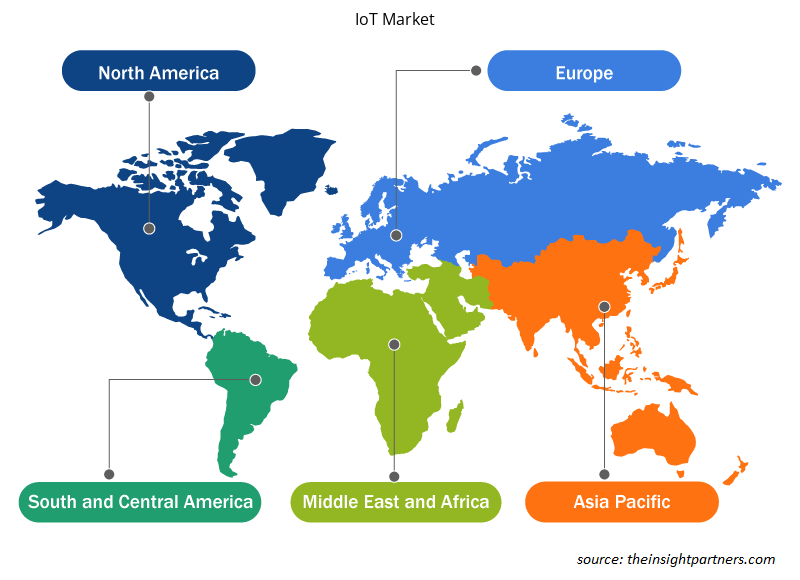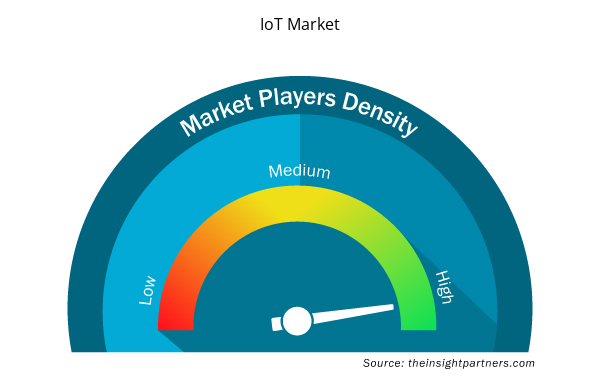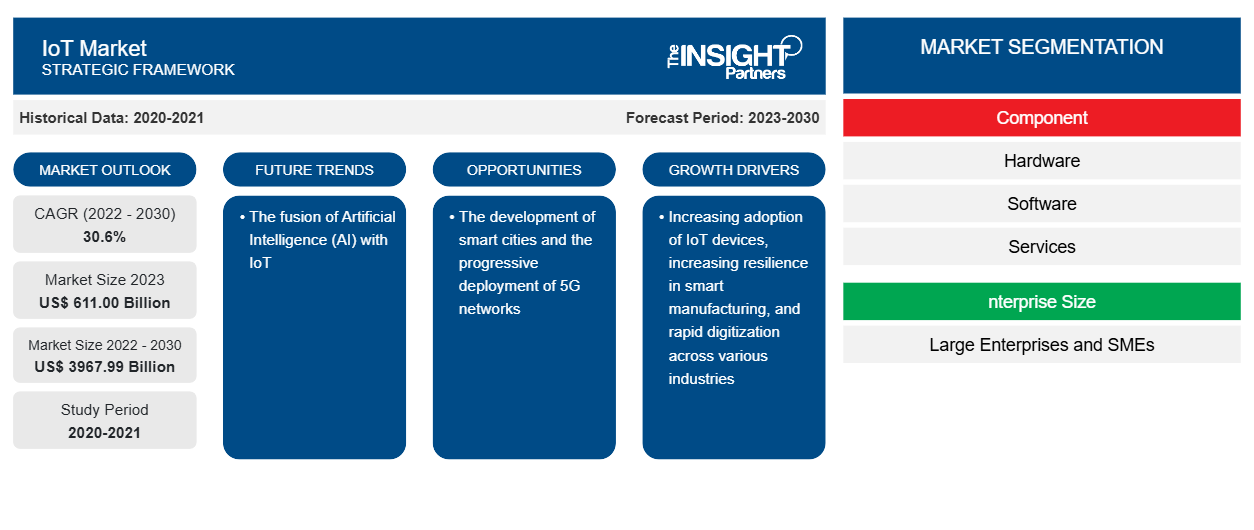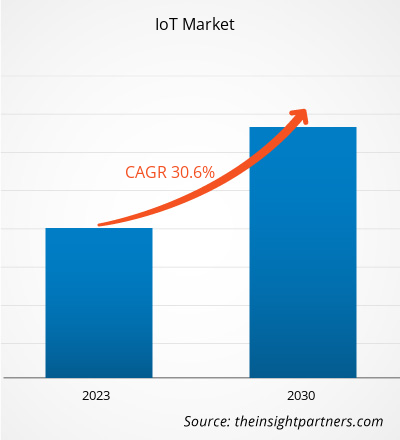من المتوقع أن يصل حجم سوق إنترنت الأشياء إلى 3967.99 مليار دولار أمريكي بحلول عام 2030 من 611.0 مليار دولار أمريكي في عام 2023. ومن المتوقع أن يسجل السوق معدل نمو سنوي مركب بنسبة 30.6٪ خلال الفترة 2023-2030. ومن المرجح أن يظل اندماج الذكاء الاصطناعي مع إنترنت الأشياء اتجاهًا رئيسيًا في السوق.
تحليل سوق إنترنت الأشياء
تتضمن سوق إنترنت الأشياء آفاق نمو بسبب اتجاهات السوق الحالية وتأثيرها المتوقع خلال فترة التنبؤ. ينمو سوق إنترنت الأشياء بسبب عوامل مثل التبني المتزايد لأجهزة إنترنت الأشياء، وزيادة المرونة في التصنيع الذكي، والتحول الرقمي السريع عبر مختلف الصناعات. يعد تطوير المدن الذكية والنشر التدريجي لشبكات الجيل الخامس من بين العوامل التي من المتوقع أن توفر فرصًا مربحة لنمو سوق إنترنت الأشياء.
نظرة عامة على سوق إنترنت الأشياء
إنترنت الأشياء، أو IoT، عبارة عن شبكة من الأجهزة المترابطة التي تتصل وتتبادل البيانات مع بعضها البعض ومع السحابة. عادةً ما تكون أجهزة إنترنت الأشياء مدمجة بتكنولوجيا مثل أجهزة الاستشعار والبرامج. تستخدم المؤسسات في مختلف الصناعات إنترنت الأشياء للعمل بكفاءة أكبر، وتقديم خدمة عملاء محسنة، وتحسين عملية اتخاذ القرار وزيادة قيمة العمل.
قم بتخصيص هذا التقرير ليناسب متطلباتك
ستحصل على تخصيص لأي تقرير - مجانًا - بما في ذلك أجزاء من هذا التقرير، أو تحليل على مستوى الدولة، وحزمة بيانات Excel، بالإضافة إلى الاستفادة من العروض والخصومات الرائعة للشركات الناشئة والجامعات
- احصل على أهم اتجاهات السوق الرئيسية لهذا التقرير.ستتضمن هذه العينة المجانية تحليلاً للبيانات، بدءًا من اتجاهات السوق وحتى التقديرات والتوقعات.
محركات وفرص سوق إنترنت الأشياء
زيادة استخدام أجهزة إنترنت الأشياء لصالح السوق
يصف إنترنت الأشياء (IoT) شبكة واسعة النطاق من الأجهزة المترابطة جنبًا إلى جنب مع التقنيات التي تمكن الاتصالات بين هذه الأجهزة والسحابة. في الآونة الأخيرة، كان هناك ارتفاع كبير في اعتماد تقنيات إنترنت الأشياء بسبب التقدم في تقنيات الاتصال المحمولة واللاسلكية، وانخفاض تدريجي في تكلفة أجهزة الاستشعار والمكونات الأخرى. تستخدم العديد من الصناعات إنترنت الأشياء لتحسين الكفاءة وتقليل تكاليف عملياتها. وفقًا لـ Finance Online، كان هناك ما يقرب من 14.76 مليار جهاز إنترنت الأشياء متصل اعتبارًا من نوفمبر 2023، ومن المتوقع أن يرتفع هذا الرقم إلى حوالي 25.44 مليار بحلول عام 2030. وفقًا لتوقعات IoT Analytics، فإن 75٪ من إجمالي الأجهزة المستخدمة ستكون إنترنت الأشياء بحلول عام 2030. علاوة على ذلك، قدرت FinleyUSA الإنفاق العالمي على إنترنت الأشياء بنحو 1.1 تريليون دولار أمريكي في عام 2023. مثل هذا التبني المتزايد لأجهزة إنترنت الأشياء يدفع نمو السوق.
تطوير المدن الذكية
يتزايد الاعتماد على التكنولوجيا لتحقيق حياة أكثر راحة مع تطور أنماط الحياة للمستهلكين والمجتمعات في جميع أنحاء العالم. اكتسبت المدن الذكية قوة جذب هائلة في العقود القليلة الماضية. وفقًا لشركة TWI Ltd.، يعيش 54٪ من سكان العالم في المدن، ومن المتوقع أن يرتفع الرقم إلى 66٪ بحلول عام 2050. وفقًا لوزارة الإسكان والشؤون الحضرية الهندية (MoHUA)، أصدرت 100 مدينة ذكية أوامر عمل لـ 7978 مشروعًا اعتبارًا من يوليو 2023، تم إكمال 5909 مشاريع منها. وفقًا لتحدي SmartAmerica، أعلنت حكومات المدن في الولايات المتحدة عن خطط لاستثمار حوالي 41 تريليون دولار أمريكي على مدى السنوات العشرين المقبلة لترقية بنيتها التحتية والاستفادة من شبكة الأجهزة المتصلة. في ديسمبر 2023، أعلن اتحاد تطوير العقارات الصيني عن استثمار يبلغ حوالي 1.85 تريليون دولار أمريكي في مدينة ذكية جديدة في البرازيل. يتم استخدام أجهزة إنترنت الأشياء بشكل متزايد في المدن الذكية، مما يوفر فرص نمو للسوق.
تحليل تجزئة تقرير سوق إنترنت الأشياء
إن القطاعات الرئيسية التي ساهمت في استخلاص تحليل سوق إنترنت الأشياء هي المكون وحجم المؤسسة والتطبيق.
- بناءً على المكون، ينقسم سوق إنترنت الأشياء إلى أجهزة وبرامج وخدمات. ومن المتوقع أن يحظى قطاع الأجهزة بحصة سوقية كبيرة في عام 2022.
- بحسب حجم المؤسسة، يتم تقسيم السوق إلى شركات كبيرة وشركات صغيرة ومتوسطة الحجم. احتلت شريحة الشركات الكبيرة الحصة الأكبر في السوق في عام 2022.
- من حيث التطبيق، تم تقسيم السوق إلى البناء والأتمتة، والطاقة الذكية والمرافق، والتصنيع الذكي، والخدمات اللوجستية المتصلة، والخدمات المصرفية والمالية، والفضاء والدفاع، وغيرها. احتل قطاع التصنيع الذكي أكبر حصة في السوق في عام 2022.
تحليل حصة سوق إنترنت الأشياء حسب المنطقة الجغرافية
ينقسم النطاق الجغرافي لتقرير سوق إنترنت الأشياء بشكل أساسي إلى خمس مناطق: أمريكا الشمالية، ومنطقة آسيا والمحيط الهادئ، وأوروبا، والشرق الأوسط وأفريقيا، وأمريكا الجنوبية والوسطى.
يشهد سوق إنترنت الأشياء في منطقة آسيا والمحيط الهادئ نموًا سريعًا، مدفوعًا بعوامل مختلفة مثل الرقمنة الضخمة لمختلف الصناعات، والنمو المرتفع لقطاع التصنيع الذكي، والدعم الحكومي المواتي.
رؤى إقليمية حول سوق إنترنت الأشياء
لقد قام المحللون في Insight Partners بشرح الاتجاهات والعوامل الإقليمية المؤثرة على سوق إنترنت الأشياء طوال فترة التوقعات بشكل شامل. يناقش هذا القسم أيضًا قطاعات سوق إنترنت الأشياء والجغرافيا في جميع أنحاء أمريكا الشمالية وأوروبا ومنطقة آسيا والمحيط الهادئ والشرق الأوسط وأفريقيا وأمريكا الجنوبية والوسطى.

- احصل على البيانات الإقليمية المحددة لسوق إنترنت الأشياء
نطاق تقرير سوق إنترنت الأشياء
| سمة التقرير | تفاصيل |
|---|---|
| حجم السوق في عام 2023 | 611.00 مليار دولار أمريكي |
| حجم السوق بحلول عام 2031 | 3967.99 مليار دولار أمريكي |
| معدل النمو السنوي المركب العالمي (2022 - 2030) | 30.6% |
| البيانات التاريخية | 2020-2021 |
| فترة التنبؤ | 2023-2030 |
| القطاعات المغطاة | حسب المكون
|
| المناطق والدول المغطاة | أمريكا الشمالية
|
| قادة السوق وملفات تعريف الشركات الرئيسية |
|
كثافة اللاعبين في سوق إنترنت الأشياء: فهم تأثيرها على ديناميكيات الأعمال
يشهد سوق إنترنت الأشياء نموًا سريعًا، مدفوعًا بالطلب المتزايد من المستخدم النهائي بسبب عوامل مثل تفضيلات المستهلكين المتطورة والتقدم التكنولوجي والوعي المتزايد بفوائد المنتج. ومع ارتفاع الطلب، تعمل الشركات على توسيع عروضها والابتكار لتلبية احتياجات المستهلكين والاستفادة من الاتجاهات الناشئة، مما يؤدي إلى زيادة نمو السوق.
تشير كثافة اللاعبين في السوق إلى توزيع الشركات أو المؤسسات العاملة في سوق أو صناعة معينة. وهي تشير إلى عدد المنافسين (اللاعبين في السوق) الموجودين في مساحة سوق معينة نسبة إلى حجمها أو قيمتها السوقية الإجمالية.
الشركات الرئيسية العاملة في سوق إنترنت الأشياء هي:
- شركة مايكروسوفت
- شركة هيوليت باكارد لتطوير المشاريع
- معهد SAS
- شركة VMware
- جوجل، ذ.م.م
- شركة أوراكل
إخلاء المسؤولية : الشركات المذكورة أعلاه ليست مرتبة بأي ترتيب معين.

- احصل على نظرة عامة على أهم اللاعبين الرئيسيين في سوق إنترنت الأشياء
أخبار سوق إنترنت الأشياء والتطورات الأخيرة
يتم تقييم سوق إنترنت الأشياء من خلال جمع البيانات النوعية والكمية بعد البحث الأولي والثانوي، والتي تتضمن منشورات الشركات المهمة وبيانات الجمعيات وقواعد البيانات. فيما يلي بعض التطورات في سوق إنترنت الأشياء:
- أبرمت شركة فودافون شراكة استراتيجية كبرى مع مايكروسوفت من شأنها أن توسع بشكل كبير قدرات إنترنت الأشياء لدى فودافون. وتهدف هذه الاتفاقية التي تمتد لعشر سنوات إلى الاستفادة من نقاط القوة لدى الشركتين لتحويل المنصات الرقمية لأكثر من 300 مليون شركة ومؤسسة في القطاع العام ومستهلك في أوروبا وأفريقيا. (المصدر: فودافون، بيان صحفي، يناير 2024)
- أعلنت شركة Soracom، Inc.، وهي شركة عالمية تقدم خدمات الاتصال المتقدمة عبر إنترنت الأشياء، وشركة Suzuki Motor Corporation، التي تقدم منتجات في فئات متعددة من التنقل، بما في ذلك السيارات والدراجات النارية والمحركات الخارجية، عن توقيع اتفاقية لمتابعة تطبيقات تقنيات إنترنت الأشياء المتقدمة في مجال خدمات التنقل. (المصدر: شركة Suzuki Motor Corporation، بيان صحفي، فبراير 2024)
تغطية تقرير سوق إنترنت الأشياء والمنتجات النهائية
يوفر تقرير "حجم سوق إنترنت الأشياء والتوقعات (2020-2030)" تحليلاً مفصلاً للسوق يغطي المجالات التالية:
- حجم سوق إنترنت الأشياء وتوقعاته على المستويات العالمية والإقليمية والوطنية لجميع قطاعات السوق الرئيسية التي يغطيها النطاق
- اتجاهات سوق إنترنت الأشياء، بالإضافة إلى ديناميكيات السوق مثل المحركات والقيود والفرص الرئيسية
- تحليل مفصل لقوى PEST/Porter الخمس وSWOT
- تحليل سوق إنترنت الأشياء يغطي اتجاهات السوق الرئيسية والإطار العالمي والإقليمي والجهات الفاعلة الرئيسية واللوائح والتطورات الأخيرة في السوق
- تحليل المشهد الصناعي والمنافسة الذي يغطي تركيز السوق، وتحليل خريطة الحرارة، واللاعبين البارزين، والتطورات الأخيرة لسوق إنترنت الأشياء
- ملفات تعريف الشركة التفصيلية
- التحليل التاريخي (سنتان)، السنة الأساسية، التوقعات (7 سنوات) مع معدل النمو السنوي المركب
- تحليل PEST و SWOT
- حجم السوق والقيمة / الحجم - عالميًا وإقليميًا وقطريًا
- الصناعة والمنافسة
- مجموعة بيانات Excel


- Third Party Logistics Market
- Cling Films Market
- Medical Audiometer Devices Market
- Online Exam Proctoring Market
- Adaptive Traffic Control System Market
- Nitrogenous Fertilizer Market
- Fishing Equipment Market
- Mice Model Market
- Emergency Department Information System (EDIS) Market
- Europe Industrial Chillers Market

Report Coverage
Revenue forecast, Company Analysis, Industry landscape, Growth factors, and Trends

Segment Covered
This text is related
to segments covered.

Regional Scope
North America, Europe, Asia Pacific, Middle East & Africa, South & Central America

Country Scope
This text is related
to country scope.
الأسئلة الشائعة
Asia Pacific is expected to dominate the IoT market with the highest market share in 2022.
The IoT market size is projected to reach US$ 3967.99 billion by 2030.
The leading players operating in the IoT market are Microsoft Corporation, Hewlett Packard Enterprise Development LP, SAS Institute Inc., VMware, Inc.; Google, LLC; Oracle Corporation; Cisco Systems, Inc.; SAP SE; IBM Corporation; and Qualcomm Technologies, Inc.
The global IoT market is expected to grow at a CAGR of 30.6% during the forecast period 2023 - 2030.
Increasing adoption of IoT devices, increasing resilience in smart manufacturing, and rapid digitization across various industries are the major factors driving the IoT market.
The fusion of artificial intelligence (AI) with IoT is anticipated to play a significant role in the global IoT market in the coming years.
The List of Companies - IoT Market
- Amazon Web Services Inc
- Cisco Systems Inc
- Google LLC
- Software AG
- International Business Machines Corp
- Intel Corp
- Microsoft Corp
- Oracle Corp
- Siemens AG
- SAP SE
The Insight Partners performs research in 4 major stages: Data Collection & Secondary Research, Primary Research, Data Analysis and Data Triangulation & Final Review.
- Data Collection and Secondary Research:
As a market research and consulting firm operating from a decade, we have published and advised several client across the globe. First step for any study will start with an assessment of currently available data and insights from existing reports. Further, historical and current market information is collected from Investor Presentations, Annual Reports, SEC Filings, etc., and other information related to company’s performance and market positioning are gathered from Paid Databases (Factiva, Hoovers, and Reuters) and various other publications available in public domain.
Several associations trade associates, technical forums, institutes, societies and organization are accessed to gain technical as well as market related insights through their publications such as research papers, blogs and press releases related to the studies are referred to get cues about the market. Further, white papers, journals, magazines, and other news articles published in last 3 years are scrutinized and analyzed to understand the current market trends.
- Primary Research:
The primarily interview analysis comprise of data obtained from industry participants interview and answers to survey questions gathered by in-house primary team.
For primary research, interviews are conducted with industry experts/CEOs/Marketing Managers/VPs/Subject Matter Experts from both demand and supply side to get a 360-degree view of the market. The primary team conducts several interviews based on the complexity of the markets to understand the various market trends and dynamics which makes research more credible and precise.
A typical research interview fulfils the following functions:
- Provides first-hand information on the market size, market trends, growth trends, competitive landscape, and outlook
- Validates and strengthens in-house secondary research findings
- Develops the analysis team’s expertise and market understanding
Primary research involves email interactions and telephone interviews for each market, category, segment, and sub-segment across geographies. The participants who typically take part in such a process include, but are not limited to:
- Industry participants: VPs, business development managers, market intelligence managers and national sales managers
- Outside experts: Valuation experts, research analysts and key opinion leaders specializing in the electronics and semiconductor industry.
Below is the breakup of our primary respondents by company, designation, and region:

Once we receive the confirmation from primary research sources or primary respondents, we finalize the base year market estimation and forecast the data as per the macroeconomic and microeconomic factors assessed during data collection.
- Data Analysis:
Once data is validated through both secondary as well as primary respondents, we finalize the market estimations by hypothesis formulation and factor analysis at regional and country level.
- Macro-Economic Factor Analysis:
We analyse macroeconomic indicators such the gross domestic product (GDP), increase in the demand for goods and services across industries, technological advancement, regional economic growth, governmental policies, the influence of COVID-19, PEST analysis, and other aspects. This analysis aids in setting benchmarks for various nations/regions and approximating market splits. Additionally, the general trend of the aforementioned components aid in determining the market's development possibilities.
- Country Level Data:
Various factors that are especially aligned to the country are taken into account to determine the market size for a certain area and country, including the presence of vendors, such as headquarters and offices, the country's GDP, demand patterns, and industry growth. To comprehend the market dynamics for the nation, a number of growth variables, inhibitors, application areas, and current market trends are researched. The aforementioned elements aid in determining the country's overall market's growth potential.
- Company Profile:
The “Table of Contents” is formulated by listing and analyzing more than 25 - 30 companies operating in the market ecosystem across geographies. However, we profile only 10 companies as a standard practice in our syndicate reports. These 10 companies comprise leading, emerging, and regional players. Nonetheless, our analysis is not restricted to the 10 listed companies, we also analyze other companies present in the market to develop a holistic view and understand the prevailing trends. The “Company Profiles” section in the report covers key facts, business description, products & services, financial information, SWOT analysis, and key developments. The financial information presented is extracted from the annual reports and official documents of the publicly listed companies. Upon collecting the information for the sections of respective companies, we verify them via various primary sources and then compile the data in respective company profiles. The company level information helps us in deriving the base number as well as in forecasting the market size.
- Developing Base Number:
Aggregation of sales statistics (2020-2022) and macro-economic factor, and other secondary and primary research insights are utilized to arrive at base number and related market shares for 2022. The data gaps are identified in this step and relevant market data is analyzed, collected from paid primary interviews or databases. On finalizing the base year market size, forecasts are developed on the basis of macro-economic, industry and market growth factors and company level analysis.
- Data Triangulation and Final Review:
The market findings and base year market size calculations are validated from supply as well as demand side. Demand side validations are based on macro-economic factor analysis and benchmarks for respective regions and countries. In case of supply side validations, revenues of major companies are estimated (in case not available) based on industry benchmark, approximate number of employees, product portfolio, and primary interviews revenues are gathered. Further revenue from target product/service segment is assessed to avoid overshooting of market statistics. In case of heavy deviations between supply and demand side values, all thes steps are repeated to achieve synchronization.
We follow an iterative model, wherein we share our research findings with Subject Matter Experts (SME’s) and Key Opinion Leaders (KOLs) until consensus view of the market is not formulated – this model negates any drastic deviation in the opinions of experts. Only validated and universally acceptable research findings are quoted in our reports.
We have important check points that we use to validate our research findings – which we call – data triangulation, where we validate the information, we generate from secondary sources with primary interviews and then we re-validate with our internal data bases and Subject matter experts. This comprehensive model enables us to deliver high quality, reliable data in shortest possible time.


 احصل على عينة مجانية لهذا التقرير
احصل على عينة مجانية لهذا التقرير